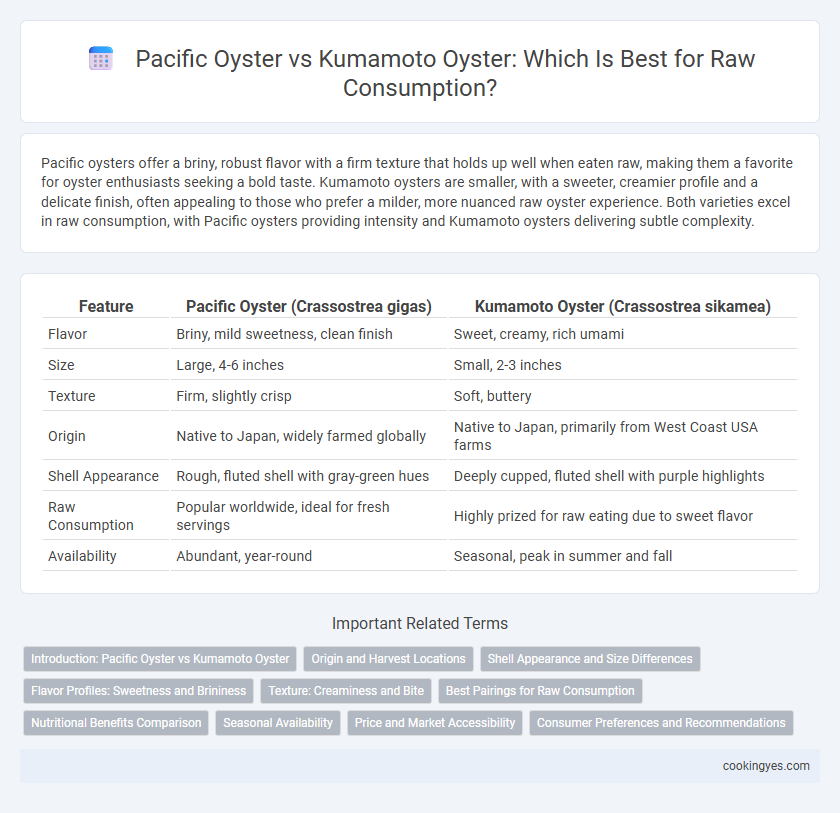Pacific oysters offer a briny, robust flavor with a firm texture that holds up well when eaten raw, making them a favorite for oyster enthusiasts seeking a bold taste. Kumamoto oysters are smaller, with a sweeter, creamier profile and a delicate finish, often appealing to those who prefer a milder, more nuanced raw oyster experience. Both varieties excel in raw consumption, with Pacific oysters providing intensity and Kumamoto oysters delivering subtle complexity.
Table of Comparison
| Feature | Pacific Oyster (Crassostrea gigas) | Kumamoto Oyster (Crassostrea sikamea) |
|---|---|---|
| Flavor | Briny, mild sweetness, clean finish | Sweet, creamy, rich umami |
| Size | Large, 4-6 inches | Small, 2-3 inches |
| Texture | Firm, slightly crisp | Soft, buttery |
| Origin | Native to Japan, widely farmed globally | Native to Japan, primarily from West Coast USA farms |
| Shell Appearance | Rough, fluted shell with gray-green hues | Deeply cupped, fluted shell with purple highlights |
| Raw Consumption | Popular worldwide, ideal for fresh servings | Highly prized for raw eating due to sweet flavor |
| Availability | Abundant, year-round | Seasonal, peak in summer and fall |
Introduction: Pacific Oyster vs Kumamoto Oyster
Pacific oysters (Crassostrea gigas) offer a robust, briny flavor with a firm texture that holds well for raw consumption, making them a popular choice worldwide. Kumamoto oysters (Crassostrea sikamea) are smaller, sweeter, and creamier with a tender texture, highly sought after for their distinct smoothness and mild flavor profile. Both oyster varieties provide unique tasting experiences that cater to different preferences in raw oyster delicacies.
Origin and Harvest Locations
The Pacific oyster (Crassostrea gigas) originates from the coastal waters of Japan and Northeast Asia, with major harvest locations extending to the Pacific coasts of North America and Europe. The Kumamoto oyster (Crassostrea sikamea), smaller and prized for its sweet flavor, is native to the southern coast of Japan and predominantly cultivated in the Pacific Northwest of the United States. Both oysters are favored for raw consumption, but Pacific oysters offer a brinier profile from colder waters, while Kumamotos deliver a more delicate taste linked to their unique origin and harvest environments.
Shell Appearance and Size Differences
Pacific oysters feature larger, fluted, and rougher shells with pronounced ridges, often measuring 4 to 8 inches in diameter, making them visually robust. Kumamoto oysters possess smaller, smoother, and more rounded shells, typically 2 to 4 inches wide, with a deep cup shape ideal for holding briny liquor. The distinct shell size and texture differences between Pacific and Kumamoto oysters directly influence their raw presentation and handling preferences.
Flavor Profiles: Sweetness and Brininess
Pacific oysters offer a balanced flavor profile characterized by moderate sweetness and a clean, crisp brininess that enhances their raw consumption appeal. Kumamoto oysters present a distinctively sweeter taste with a mild, buttery texture and subtle saltiness, making them favored for their delicate and nuanced flavor. The contrast between the Pacific oyster's pronounced briny notes and the Kumamoto oyster's gentle sweetness caters to diverse palates seeking fresh, raw oyster experiences.
Texture: Creaminess and Bite
Pacific oysters offer a firm bite with a refreshing, slightly briny flavor and a smooth texture, making them ideal for raw consumption. Kumamoto oysters are prized for their creamy, buttery texture and sweet, mild taste, delivering a luxurious mouthfeel with a soft, tender bite. Both varieties excel in raw dishes but cater to different texture preferences: Pacific oysters provide a crisp chew, while Kumamotos excel in creaminess.
Best Pairings for Raw Consumption
Pacific oysters offer a briny, slightly sweet flavor with a crisp texture, pairing excellently with citrus-based mignonettes, light white wines like Sauvignon Blanc, or a splash of dry sake to enhance their natural freshness. Kumamoto oysters possess a creamy, buttery profile with subtle nuttiness, ideal when complemented by mild accompaniments such as a gentle ponzu sauce or a squeeze of yuzu for an aromatic citrus twist. Both oysters benefit from simple, clean pairings that highlight their distinct taste nuances without overpowering the delicate raw experience.
Nutritional Benefits Comparison
Pacific oysters contain higher levels of zinc and iron compared to Kumamoto oysters, supporting immune function and oxygen transport in the body. Kumamoto oysters offer a richer concentration of vitamin B12, essential for nerve health and energy production. Both varieties provide significant amounts of protein and omega-3 fatty acids, promoting cardiovascular health and muscle repair.
Seasonal Availability
Pacific oysters (Crassostrea gigas) are widely available year-round with peak freshness in the cooler months from late fall to early spring, making them ideal for raw consumption during these seasons. Kumamoto oysters (Crassostrea sikamea) have a more limited seasonal availability, typically thriving in late summer through early fall, offering a sweeter and creamier texture when consumed raw. Seasonal fluctuations affect the flavor profiles and optimal harvest times, influencing consumer preference between these two popular oyster varieties.
Price and Market Accessibility
Pacific oysters typically offer a more affordable price point and are widely available in global markets, making them a popular choice for raw consumption. Kumamoto oysters, known for their sweeter flavor and smaller size, generally command a higher price and are less accessible outside specialty seafood retailers. Market accessibility for Kumamoto oysters is often limited to coastal regions and upscale markets, while Pacific oysters enjoy broader distribution due to their faster growth and larger harvest volumes.
Consumer Preferences and Recommendations
Pacific oysters are favored for their larger size and briny, robust flavor, making them ideal for those who enjoy a bold taste in raw shellfish. Kumamoto oysters, smaller and sweeter with a creamy texture, attract consumers who prefer mellower, buttery notes and a more delicate experience. For raw consumption, expert recommendations suggest Pacific oysters for oyster lovers seeking strong oceanic flavors, while Kumamoto oysters suit beginners or those with a preference for subtle sweetness.
Pacific oyster vs Kumamoto oyster for raw consumption Infographic

 cookingyes.com
cookingyes.com